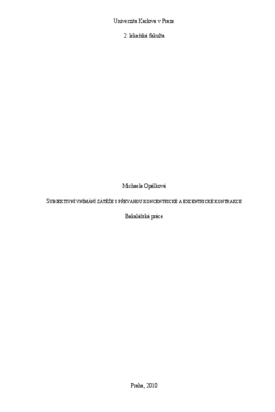Subjektivní vnímání zátěže s převahou koncentrické a excentrické kontrakce
Subjective perception of during predominantly concentric and predominantly eccentric excercise
bachelor thesis (DEFENDED)

View/
Permanent link
http://hdl.handle.net/20.500.11956/24466Identifiers
Study Information System: 86180
CU Caralogue: 990012317690106986
Collections
- Kvalifikační práce [1908]
Author
Advisor
Referee
Doubková, Lucie
Faculty / Institute
Second Faculty of Medicine
Discipline
Physiotherapy
Department
Department of Rehabilitation and Sports Medicine
Date of defense
20. 5. 2010
Publisher
Univerzita Karlova, 2. lékařská fakultaLanguage
Czech
Grade
Excellent
Práce se věnuje struktuře a funkci kosterního svalu. Popisuje podobu sarkomery a současné teorie kontrakce. Kromě tradiční teorie klouzajících sarkomer je zahrnut i nový pohled tzv. rotační teorie založené na pohybu vzájemně funkčně propojených šroubovic. Jsou shrnuty současné poznatky o reakci svalu na změnu délky při různém stupni aktivace. Kapitola Řízení pohybu není vyčerpávající, jejím úkolem je spíše podat přehled o rozdílnosti řízení v závislosti na druhu prováděné kontrakce. Další části shrnují integraci excentrické kontrakce do lidského pohybu, okamžité reakce i adaptační procesy. Poslední kapitola teoretické části pojednává o subjektivním vnímání zátěže, opět především zátěže s převahou excentrické kontrakce v porovnání se zátěží s převahou koncentrické kontrakce. Praktická část práce obsahuje výsledky měření HRpeak při doběhnutí, HRav a subjektivního hodnocení fyzického a psychického rozpoložení před a po zátěži s převahou koncentrické kontrakce (běh do kopce) a zátěži s převahou excentrické kontrakce (běh z kopce), kterou podstoupilo 12 gymnaziálních studentek. Powered by TCPDF (www.tcpdf.org)
This thesis pursues the function of human skeletal muscle. It describes the sarcomere and current theories of the muscle contraction. In addition to conventional sliding sarcomere theory the new large - scale model is included. It is called rotational theory and it works on the basis of rotating helical molecules which are functionally coupled. Muscle reaction to stretching in dependence on the stretch length and velocity are folded in. The chapter Neural Commands is not comprehensive. Its purpose is to review the differences between neural control of concentric and eccentric contraction, respectively. Following parts summarize the integration of eccentric contraction into human movement, instantaneous reactions and adaptation processes. The last theoretical part deals with subjective perception of stress during predominantly concentric and predominantly eccentric exercise. The applied part consists of the outcomes of measurement of peak and averaged heart rate before and after bouts of running with predominantly concentric (uphill running) and predominantly eccentric (downhill running) exercise. Subjective rate of physical and psychical condition were registered at identical situation using visual analogue scale. Twelve high school students were measured. Powered by TCPDF (www.tcpdf.org)
